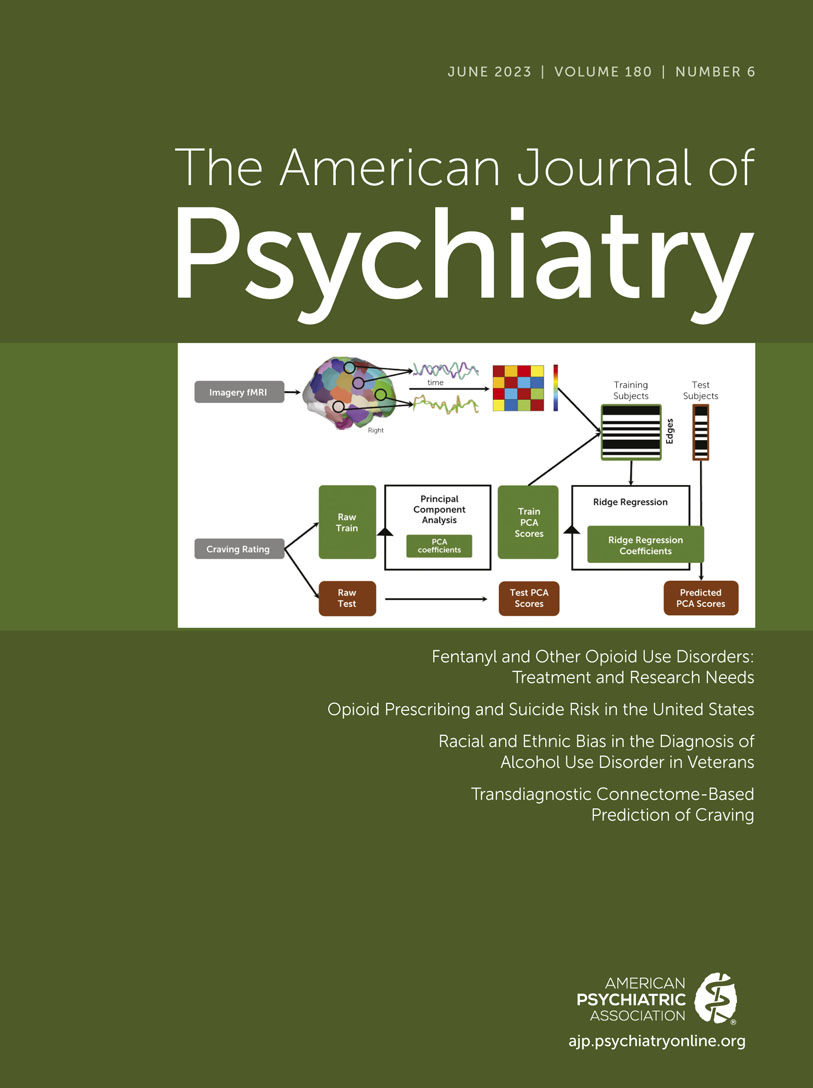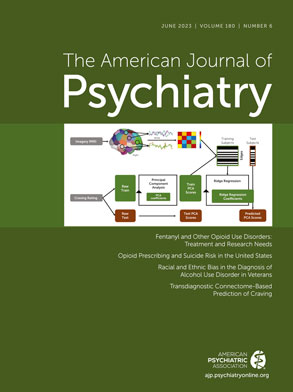New-onset psychosis is always disconcerting and alarming for patients, families, and clinicians. Although some acute psychotic disorders are brief and resolve in a short period of time, others progress to schizophrenia or bipolar disorder and have a long-term impact on people’s mental health and quality of life. Substance-induced psychotic disorders are brief psychotic syndromes triggered by substance use that persist for days or weeks after intoxication has resolved. Abundant evidence suggests that individuals presenting to mental health services with substance-induced psychotic disorders have a significant risk of later transition to schizophrenia or, more generally, to a chronic psychotic disorder. A recent meta-analysis (
1) of 25 studies providing substance-specific estimates of transition to schizophrenia spectrum disorders among more than 34,000 individuals with substance-induced psychotic disorder estimated a pooled transition rate of 25% across all substances, with differential rates depending on the substance.
Population-based register studies may provide more accurate estimates of transition rates than studies of research cohorts because of larger and more representative sampling and longer follow-up periods. In this context, large studies using national registers have been conducted in Scandinavia and Scotland (
2–
5). These studies confirm that a considerable number of patients with an initial diagnosis of substance-induced psychotic disorder receive a later diagnosis of schizophrenia or schizophrenia spectrum disorder, although the reported transition rates differed across studies. This is partly attributable to differences in the recruitment of patients with substance-induced psychotic disorder (for example, studies restricted to inpatients reported higher transition rates), possible differences in the exclusion of individuals with prodromal schizophrenia from the group with substance-induced psychotic disorder, and the definition of the outcome (narrowly defined schizophrenia or more broadly defined psychotic disorders). Despite these differences, common patterns were observed: men and people who developed substance-induced psychotic disorder early in life had a higher risk of later diagnosis of schizophrenia spectrum disorder, most transitions from substance-induced psychotic disorder to schizophrenia spectrum disorder occurred within the first 2–3 years, and cannabis- and alcohol-induced psychotic disorders had the highest and lowest transition rates, respectively, with other substances falling between the two.
In this issue of the
Journal, Rognli et al. (
6) report on a Norwegian Patient Registry study in which they identified all the inpatients and outpatients diagnosed with substance-induced psychotic disorder between 2010 and 2015 (N=3,187) and used longitudinal data to establish subsequent diagnoses of chronic psychotic disorders. The authors investigated transitions to schizophrenia spectrum disorder as well as transitions to bipolar disorder, the latter of which, despite compelling evidence of an association with substance misuse (
7), has received little attention in previous studies (
4). They estimated 6-year cumulative rates of 27.6% for transition to schizophrenia spectrum disorder (the rate dropped to 18.8% in a sensitivity analysis that restricted the outcome to schizophrenia) and 4.5% for transition to bipolar disorder. Transition rates to schizophrenia spectrum disorder were higher among younger men and individuals with psychotic disorders induced by cannabis (36.0%) or multiple substances (32.0%) and lower among individuals with alcohol-induced psychosis (13.2%). These results were similar to the pooled estimates from the previous meta-analysis (
1). The transition rate to bipolar disorder was lower overall (4.5%) and twice as high among women (7.1%) than among men (3.5%). The median time from substance-induced psychotic disorder to a diagnosis of schizophrenia spectrum disorder was 0.8 years, and time to a diagnosis of bipolar disorder was 1 year. Rognli et al. also examined predictors of transition and found that younger age among men and number of emergency admissions for substance-induced psychotic disorder in both sexes were associated with higher rates of transition to schizophrenia spectrum disorder. A similar trend was observed for the association of number of emergency admissions with transition to bipolar disorder; however, because of the smaller number of individuals, this analysis was likely underpowered.
The unequivocally high conversion rate from substance-induced psychotic disorder to chronic psychotic disorder raises important questions. The first is whether it demonstrates an increased risk of individuals with substance-induced psychotic disorder (representing a separate nosological entity) later developing schizophrenia spectrum disorder or whether patients with substance-induced psychotic disorder are already in the prodromal phase of schizophrenia with psychotic symptoms possibly triggered by substance abuse (a question of misclassification). This is difficult to resolve through register-based studies, but we can draw some conclusions from the available evidence. Rognli et al. observed that repeated emergency admissions increase the risk of transition to schizophrenia spectrum disorder. It is possible that repeated emergency admissions are indicators of more severe substance use, poorer mental health, or less social support, but the authors also raise the hypothesis of misclassification, where the development of substance-induced psychosis represents “a transitional step toward schizophrenia.” It is likely that repeated emergency admissions related to substance-induced psychotic disorder indicate an early phase of schizophrenia that has not yet been diagnosed. In this line of reasoning, the similar or higher transition rate for other brief and atypical psychoses compared with substance-induced psychotic disorder reported by Murrie et al. (
1) can be interpreted as an indication that the risk of chronic psychosis is increased following all types of acute psychotic disorders and is not specific to the ones related to substance use. Conversely, the observation by Kendler et al. (
5) of an elevated familial risk mostly for drug and alcohol use disorder and less so for nonaffective psychosis among individuals with substance-induced psychotic disorder suggests an etiological pathway associated with liability to drug abuse. However, the best predictor for the transition from substance-induced psychotic disorder to schizophrenia was the familial risk for psychosis, and this familial risk was indistinguishable from that for patients with schizophrenia without a history of substance-induced psychotic disorder (
5). Taken together, these observations suggest that substance-induced psychotic disorders comprise a constellation of psychoses that are etiologically linked with drug use or represent prodromal phases of schizophrenia triggered by drug use.
The second question is whether there is a causal link between substance use and chronic psychosis. This is particularly important given the increased availability of substances for both medicinal and recreational use (e.g., legalization of cannabis use in several U.S. states) (
8,
9). As discussed by Rognli et al., most evidence for a causal link involves cannabis and is supported by a dose-response relationship in terms of amount and frequency of use (
10) or potency of cannabis (
11). Nonetheless, causality cannot be assessed in the context of observational studies, and alternative explanations have been proposed, including confounding, pleiotropy, and reverse causality. Recent Mendelian randomization studies have attempted to make causal inferences, although the findings have been inconsistent. Most of these studies identified bidirectional effects from cannabis use to schizophrenia and vice versa; however, these types of studies have been limited by the availability of genetic instruments for cannabis use (
12–
14).
As with other register-based studies, limitations associated with registries need to be taken into consideration when interpreting the findings; the most important limitation is the lack of validation of the recorded diagnoses. It is logical to expect the quality of diagnostic practices to vary depending on the setting and the experience of clinicians who made the diagnoses. However, we should also bear in mind that this represents the variability in normal clinical practice and therefore may increase the generalizability of the findings. Other limitations include the relatively short follow-up period and the possibility of misclassification of individuals exposed to more than one substance.
Regardless of whether drugs have a causal effect on the development of schizophrenia, patients with substance-induced psychotic disorder carry a substantial risk of transition to chronic psychotic disorders that makes them an important target group for early intervention. Because chronic psychotic disorders do not arise solely as a result of the psychotogenic effects of drugs of abuse (
5), reduction in use or abstinence is not sufficient; close monitoring of patients with substance-induced psychotic disorder and other preventive measures should be considered. In addition to interventions aimed at the universal reduction of substance abuse, identifying which individuals among those with substance-induced psychotic disorder have the highest risk of transition is of paramount importance. In this regard, this study adds to the evidence that young men, particularly those with cannabis-induced psychosis, are at high risk of transition to schizophrenia spectrum disorder and identifies patients with repeated emergency admissions as an exceptionally high-risk group that could be targeted by early intervention efforts. Future research should aim to elucidate potential causal effects of substances on chronic psychosis and to identify specific pathways leading to the development of schizophrenia and bipolar disorder.

